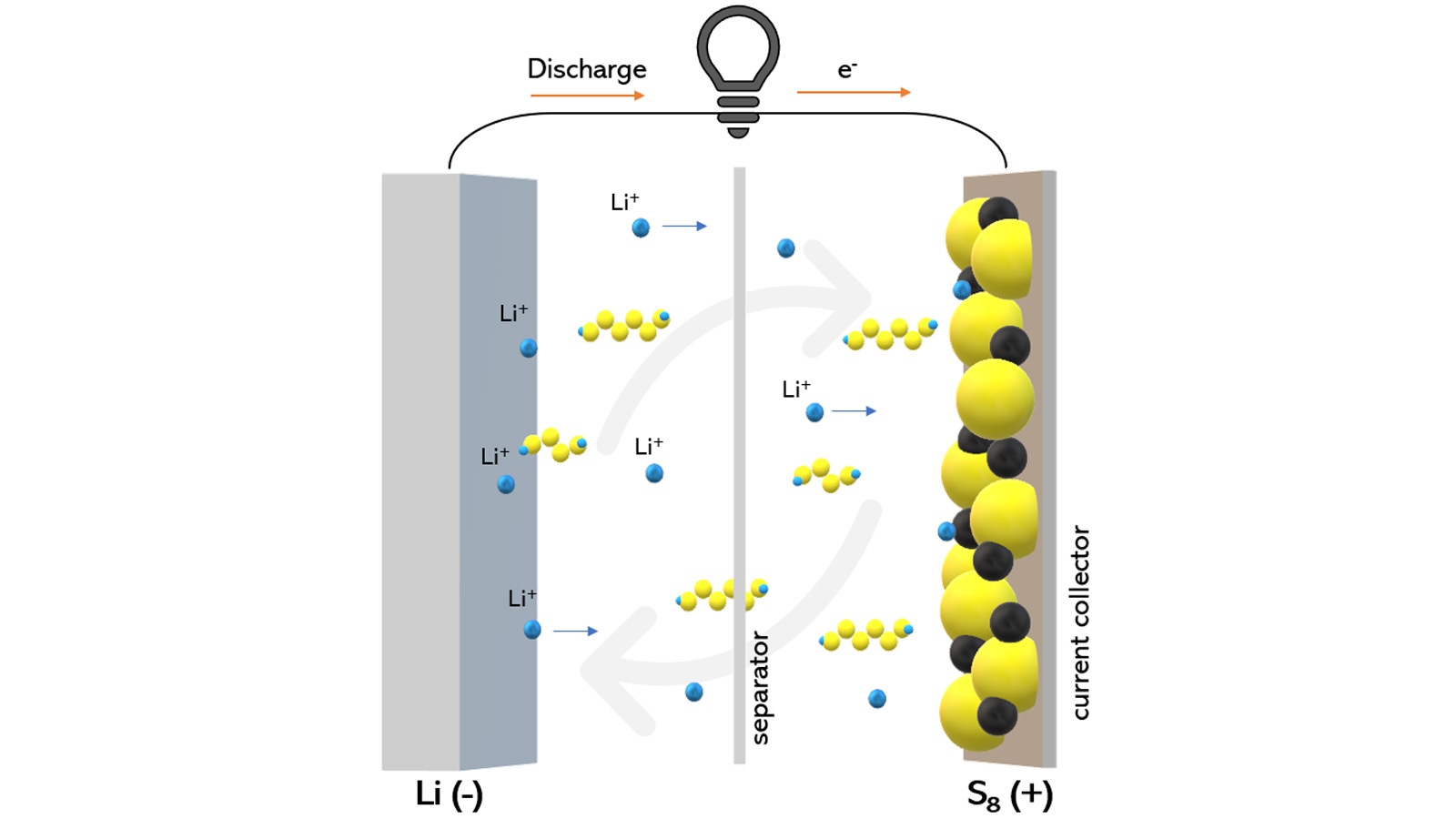In theory, lithium-sulfur batteries (LSBs) have a much higher charge density than lithium-ion batteries. They are also far more cost-effective due to the ubiquity and low cost of sulfur. Combined, these two factors demonstrate that LSBs could be a promising alternative to lithium-ion batteries. In practice however, two main issues have plagued LSBs: poor life cycle and low energy efficiency.
In a published article in Advanced Energy Materials, researchers at the U.S. Department of Energy’s (DOE) Argonne National Laboratory, in cooperation with the National Research Foundation of Korea, have been revisiting how the sulfur host materials’ ability to attract charged particles, or polarity, and ability to transmit current, or conductivity, can address these two issues and result in a greater viability of long-life LSBs.
The shortened life cycle of LSBs can be attributed to a process known as the “polysulfide shuttle.” “The shuttle is responsible for leaching material from the cathode of the battery,” explained Senior Materials Group Leader/Argonne Distinguished Fellow Khalil Amine. “This removal of material degrades the cathode and results in a decreased life span for the battery.” As reactions between the lithium and sulfur occur, the polysulfide intermediaries created during the process dissolve away from the cathode.
“Our work shows that the key to enhancing the long-term stability of LSBs is enhancing the polarity and enhancing the interactions with the polysulfides at the cathode. If you can stabilize the sulfur, then you can stabilize the battery.” — Khalil Amine
Not only is removal of sulfur material from the cathode due to the polysulfide shuttle an issue with LSBs, but the sulfur itself is incredibly insulative, making it significantly less conductive. “It’s the combined issues of dissolution and lack of conductivity that present significant obstacles to the development of long-life LSBs,” said Assistant Chemist Gui-Liang Xu.
While earlier work in the field had shown that the introduction of carbon into the cathode structure can address the conductivity issues, there exists debate over what would improve the performance of LSBs the most: addressing the conductivity or addressing the polarity of the cathode.
Amine and his team set about developing two different cathode structures to address this debate. One cathode utilized polar but nonconductive mesoporous silica while the other utilized conductive, but nonpolar mesoporous carbon. “The two cathodes were designed to be exact replicas of one another apart from the use of either silica or carbon,” said Amine. “This way, we could determine whether a more polar cathode or a more conductive cathode improved the longevity of the battery.”
Using physical and electrochemical probes, the researchers discovered that the results of their work indicated that the polar, nonconductive cathode worked best. Xu said, “We found that under varying cycling rates and loadings, even at high current densities, the polar, silica-based cathode showed much greater performance than the nonpolar, carbon-based cathode.”
Amine further explained that, “the stronger interaction between the polysulfides and the silica immobilizes these intermediaries,” thus decreasing the effect of the polysulfide shuttle and extending the life of the battery. “Our work shows that the key to enhancing the long-term stability of LSBs is enhancing the polarity and enhancing the interactions with the polysulfides at the cathode. If you can stabilize the sulfur, then you can stabilize the battery.” With this novel cathode structure, Amine and his team have demonstrated the practical strength of LSBs and shown that they can make for viable, cheaper alternatives to lithium-ion batteries.
This research was sponsored by the U.S. Department of Energy’s Office of Energy Efficiency and Renewable Energy, Vehicle Technologies Office (VTO) Battery Materials Research (BMR) Program; and the National Research Foundation (NRF) of Korea.
Lee, B.‐J., Kang, T.‐H., Lee, H.‐Y., Samdani, J. S., Jung, Y., Zhang, C., Yu, Z., Xu, G.‐L., Cheng, L., Byun, S., Lee, Y. M., Amine, K., Yu, J.‐S., Revisiting the Role of Conductivity and Polarity of Host Materials for Long‐Life Lithium–Sulfur Battery. Adv. Energy Mater. 2020, 10, 1903934. https://doi.org/10.1002/aenm.201903934
Argonne National Laboratory seeks solutions to pressing national problems in science and technology. The nation’s first national laboratory, Argonne conducts leading-edge basic and applied scientific research in virtually every scientific discipline. Argonne researchers work closely with researchers from hundreds of companies, universities, and federal, state and municipal agencies to help them solve their specific problems, advance America’s scientific leadership and prepare the nation for a better future. With employees from more than 60 nations, Argonne is managed by UChicago Argonne, LLC for the U.S. Department of Energy’s Office of Science.
The U.S. Department of Energy’s Office of Science is the single largest supporter of basic research in the physical sciences in the United States and is working to address some of the most pressing challenges of our time. For more information, visit https://energy.gov/science.


